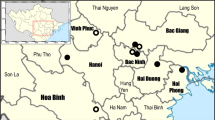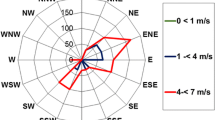Abstract
A comprehensive research of the polycyclic aromatic hydrocarbons (PAHs) emission from domestic waste incinerators in northern areas of Vietnam, were investigated. Sixty-four samples from two domestic waste incinerators were collected and analyzed for PAHs. The PAHs concentrations in the samples were determined using gas chromatography coupled with mass spectrometry. In April, June, September, and November 2021, Σ16PAHs mean concentrations in chimney air samples were 970.9 ± 57.4, 1061.9 ± 49.8, 1070.7 ± 41.3 and 1136.1 ± 136.5 µg m−3, respectively. The mean emission factors of Σ16PAHs were 7.5 mg/kg. The mean percentages of low molecular weight PAHs were predominant in the analyzed air samples. The toxic equivalent quotient of samples ranged from 30.7 to 41.7 mg/kg, whereas the incremental lifetime cancer risk exceeded 10− 3. This results implied a high level of concern with potentially negative health consequences. The four diagnostic ratios of PAHs were found and can be used for identification of sources markers from domestic waste incinerators.
Similar content being viewed by others
Explore related subjects
Discover the latest articles, news and stories from top researchers in related subjects.Avoid common mistakes on your manuscript.
Polycyclic aromatic hydrocarbons (PAHs), known as a group of organic chemicals containing fused aromatic rings, were found to be primarily emitted from incomplete combustion such as in various industrial procedures and incinerators (Patel et al. 2020). The scientific community’s concern about the possible impacts of PAHs on the environment and human exposure has vigorously received attention nowadays (Anh et al. 2019). People may are exposed to PAHs in their daily lives through the breathing of indoor and outdoor air, food ingestion, and direct contact (Abdel-Shafy and Mansour 2016). Several reports demonstrated health problems caused by PAH exposure, including abnormalities in reproductive systems, reduced lung function, hormonal imbalance, myocardial infarctions, mutations, carcinogens, and neurological conditions (Al-Harbi et al. 2020).
Incineration is the most common solid waste treatment method over the world, but it can release large quantities of toxic compounds during combustion (Lu et al. 2017). Li et al. (2019) observed that a self-designed small-scale waste incinerator in Shenzhen emitted 16 PAH in October 2017. According to Shu et al. (2018), PAHs were found in two waste incinerators in Shenzhen, China. Several research projects have been carried out in different environments in Vietnam, to determine how PAHs are emitted by a variety of sources (Anh et al. 2019; Phuong et al. 2022). However, little data is available concerning PAH emissions via small scale domestic waste incinerators (SSI) in Vietnam. The present study aims to fill this gap by following the objectives: (1) assessing the pollution level of PAHs in the SSI in typical northern province of Vietnam; (2) evaluating the emission factor and PAHs diagnostic ratio of source markers; (3) evaluating the human health risk of PAHs in the study area.
Materials and Methods
The two SSI in Nam Dinh province (Fig. 1), one typical provinces in northern Vietnam, were selected. Four sampling campaigns in April, June, September and November 2021 were conducted with 40 ambient air samples and 24 air samples emitted from chimneys of SSI. The SSI in Nam Dinh uses a Losiho technology with a capacity of 350 kg/hour to treat domestic waste generated in the communes. PAHs air samples in the chimneys of SSI and ambient air were taken according to the instructions in Circular No. 40/2015/TT – Ministry of natural resources and environment, Vietnam and National Institute for Occupational Safety and Health, respectively (MONRE 2015; NIOSH 2003). In the chimneys, the samples were taken isokinetically using the train may be constructed by adaptation of an ARB Method 5 train. To adsorb PAHs samples, a sorbent trap containing Amberlite resin (XAD–2) was used. The flue gas flow rate was measured by the integrated manometer in the train, and the isokinetic sampling gradient rate was maintained automatically by the device. In the ambient air, samples were absorbed by charcoal sorbent tubes were utilized (SKC, USA). PAHs standard and other chemicals are purchased from Cambridge Isotope Lab and Supelco, Switzerland. Totally, sixteen typical PAHs were selected including: naphthalene (Nap), acenaphthylene (Acy), acenaphthene (Ace), fluorene (Flu), phenanthrene (Phe), anthracene (Ant), pyrene (Py), fluoranthene (Flt), benzo[a]anthracene (BaA), chrysene (Chr), benzo[b]fluoranthene (BbF), benzo[k]-fluoranthene (BkF), benzo[a]pyrene (BaP), indeno [1,2,3-cd]pyrene (Ind), benzo [g,h,i]-pyrene (BghiP) and dibenzo[a,h]anthracene (DahA).
For chemical analysis of PAHs, the air samples were spiked with deuterated PAHs surrogate standards (naphthalene-d8, acenaphthylene-d8, phenanthrene-d10, fluoranthene-d10, pyrene-d10, benzo[a]pyrene-d12, and benzo[g,h,i] perylene-d12) and followed by 10 g of Na2SO4. The procedures of Soxhlet extraction were applied by using 300mL of mixture [n-hexane: acetone (1:1)] within 24 h. After extraction, the samples were distilled by vacuum rotation to of volume about 5 mL. The samples were cleaned with silicagel and reduced volume in nitrogen evaporator to 1mL then spiked with chrysen-d12 as internal standard. The samples were analyzed on a gas chromatography (Thermo Scientific Model IQS 7000) equipped with a mass spectrometer detector. The capillary column DB-5MS (30 m × 0.25 mm i.d × 0.25 μm thickness) was used. The method detection limits ranged from 3.6 to 8.3 ng m–3. Duplicates of samples were performed and relative standard deviations were less than 10%. The PAHs recoveries ranged from 94% to 98%. For each set of five real samples, a blank sample was performed.
To assess the human health risk of PAHs exposure, toxic equivalent quotient (TEQ) and incremental lifetime cancer risk (ILCR) were used. ∑TEQ was calculated as follows: ∑TEQ = ∑(CPAHs.TEFPAHs). TEFPAHs indicate the toxicity equivalency factors and CPAHs represents the concentration of each representative PAHs. The incremental lifetime cancer risk (ILCR) was calculated follow the US EPA (2011), Anh et al. (2019), Zivancec et al. (2022). The ILCR was estimated to use the equations listed below:
where the CS is the BaP-equivalent concentration of PAHs in air (µg kg−1, calculated using equivalency factors). Carcinogenic slope factors (CSF) of inhalation, ingestion, and dermal contact were of 3.85, 7.3, and 25 (mg/kg/day)−1, respectively (Zivancec et al. 2022). The other variables are described by US EPA (2009), Zivancec et al. (2022) and given in Table 1. ILCR classified as low, moderate and high risk with the values < 10−6, 10−6−10−4, > 10−4, respectively (US EPA. 2009). The PAHs emission factor (EF, mg/kg) was calculated follow the equations: EF = CPAHs. r2. 3.14. v. t/m, where: r is the chimney radius (0.25 m), v is the exhaust gas speed (4.1 m/s), t is the sampling time (3600 s); m is the mass of waste burned during the sampling period (350 kg).
Results and Discussion
In the present study, all 16 PAHs in the air samples from the chimneys of SSI were detected (Table 2). From April to November 2022, the sum of 16 PAHs concentrations (Σ16PAHs) had a slightly seasonal variation. The range and mean of Σ16PAHs concentrations were follow the order: November (965.1–1325.1, 1136.1 ± 136.5 µg m−3) > September (1018.9−1127.9, 1070.7 ± 41.3 µg m−3) ~ June (999.6–1130.9, 1061.9 ± 49.8 µg m−3) > April (898.3–1043.6, 970.9 ± 57.4 µg m−3). The PAHs emission in the SSI is related to the input materials, the water content in the biomass, and the combustion technology (Chen et al. 2013). Thus, the main reasons of PAHs concentration variation were that the organic matter and water content in burning domestic wastes changed with the seasons.
Among sixteen typical PAHs, eight carcinogenic PAHs (Σ8C-PAHs: BaA, Chr, BbF, BkF, BaP, Ind, BghiP and DahA) were more toxic. The Σ8C-PAHs concentrations were follow the order: November (220.1–456.9 µg m−3) > September (265.6−326.1 µg m− 3) > June (227.1–272.7 µg m− 3) > April (215.3–258.8 µg m−3). Significant Σ8C-PAHs concentrations could affected human health of workers in the study area. Strong positive correlation between Σ16PAHs and Σ8C-PAHs in samples was found (r2 = 0.98). Studies on the emission factor of PAHs have been implemented from some materials in Vietnam. In this study, the mean PAHs emission factors of burning domestic solid waste were calculated (Table 3). The mean EF of Σ16PAHs in this study (7.5 ± 0.7 mg/kg) were higher than hood experiment (mean 1.8 mg/kg) and leaf litter (mean 0.91 mg/kg) but smaller than burning rice straw (mean 12.53 mg/kg) (Phuong et al. 2022; Oanh et al. 2011). This is among the systematic investigations of PAHs emissions from domestic waste incinerators in rural areas in the North of Vietnam, so the results obtained will contribute a positive part to the inventory of PAHs emissions.
In the ambient air around SSI, the Σ16PAHs concentrations in air samples were also follow the order: November (868.6–1192.5 µg m−3) > September (916.9–1015.1 µg.m−3)–June (899.6–1017.8 µg m−3) > April (808.5–993.2 µg m−3). Currently, Vietnam has no standard for the limitation of total concentration of 16 PAH in ambient air. The significant emission of PAH from the SSI chimney indicates that the incinerator needs to be equipped with a more efficient exhaust gas treatment system, as well as a regulation on the total concentration of PAH in the ambient air soon. The concentration of total PAHs in this study was significantly higher than in the samples collected from Vietnam’s urban and vehicular waste processing areas (Anh et al. 2020), and in road samples in northern Vietnam (Anh et al. 2019).
In addition, mean PAHs percentages tends to decrease in order: L-PAHs > M-PAH > H-PAH among sampling sites, in which Nap had the highest percentages, followed by Acy, Phe, and finally, the lowest percentages were DahA in analyzed samples (Fig. 2). Chen et al. (2013) reported that simple incineration conditions are more favorable to further decomposition and transformation of L-PAHs.
PAHs source markers have been used as being indicators for several processes. Typically, high concentrations of Py, Flt, and Phe indicated the emission from incineration (Fig. 2). Because of two major PAH sources: petrogenic and pyrogenic, therefore four PAH ratios were chosen to determine the characteristic source of PAH emissions: Ant/(Ant+Phe), Flt/(Flt+Py), BaA/(BaA+Chr), and Ind/(Ind+BghiP) in this study. The results obtained about the value range of the four indicator ratios below are the necessary reference data to identify the source of PAH emissions from SSI for other studies (Fig. 3).
The diagnostic ratios of Ant/(Ant+Phe), Flt/(Flt+Pyr), BaA/(BaA+Chr), and Ind/(Ind+BghiP) ranged from 0.129 to 0.131, 0.37–0.38, 0.17–0.18, and 0.35–0.37, respectively. Compared with recent reports, the four ratios were higher than these ratios in the combustion of 11 types of biomass with lower moisture (below 0.9%) in a tube furnace (Samae et al. 2021) and lower than burned three types of biomass with 6.51 to 12.2% moisture in a self-designed stainless steel chamber (Wiriya et al. 2016).
From the above results, the risk of PAH exposure around the incinerator area was of great concern. The TEQ values in analyzed samples ranged from 30.7 to 41.7 mg/kg. When compared to previous studies, the TEQ values from this study were significantly higher than values reported for samples in Tokyo, Japan (0.60–2.00 mg/kg), and samples in Serbia (0.03–0.15 mg/kg) (Khanal et al. 2018; Zivancec et al. 2022). Besides, the ILCRtotal ranged from 2.7· 10−3 to 3.6· 10−3. Given that the ILCR values in two incinerations were > 10− 3, this causes significant concern about a high risk to human health in the study area, especially for workers (Anh et al. 2019; Zivancec et al. 2022). The findings of this study show that the ILCRtotal values were higher than in the previous study (1.1·10−6−1.3·10−5) in the end-of-life vehicle area from Bac Giang province, Vietnam; indicating an alarming level of occupational cancer and recommended that workers be protected from occupational cancer through the use of protective conditions (Anh et al. 2019).
Change history
30 May 2024
A Correction to this paper has been published: https://doi.org/10.1007/s00128-024-03908-8
References
Abdel-Shafy H, Mansour MSM (2016) A review on polycyclic aromatic hydrocarbons: source, environmental impact, effect on human health and remediation. Egypt J Pet 25:107–123
Al-Harbi M, Alhajri I, Whalen JK (2020) Health risks associated with the polycyclic aromatic hydrocarbons in indoor dust collected from houses in Kawait. Environ Pollut 266:115054
Anh HQ, Tue NM, Tuyen LH, Minh TB, Viet PH, Takahashi S (2019) Polycyclic aromatic hydrocarbons and their methylated derivatives in settled dusts from end-of-life vehicle processing, urban, and rural areas, northern Vietnam: occurrence, source apportionment, and risk assessment. Sci of the Total Environ 672(1):468–478
Anh HQ, Watanabe I, Tue NM, Tuyen LH, Viet PH, Chi NK, Minh TB, Takahashi S (2020) Polyurethane foam-based passive air sampling for simultaneous determination of POP- and PAH- related compounds: a case study in informal waste processing and urban areas, northern Vietnam. Chemosphere 247:125991
Chen Y, Zhao R, Xue J, Li J (2013) Generation and distribution of PAHs in the process of medical waste incineration. Waste Manag 33:1165–1173
Khanal R, Furumai H, Nakajima F, Yoshimura C (2018) Carcinogenic profile, toxicity and source apportionment of polycyclic aromatic hydrocarbons accumulated from urban road dust in Tokyo, Japan. Ecotoxicol Environ Saf 165:440–449
Li HY, Gao PP, Ni HG (2019) Emission characteristics of parent and halogenated PAHs in simulated municipal solid waste incineration. Sci of the Total Environ 665:11–17
Lu JW, Zhang SK, Hai J, Lei M (2017) Status and perspectives of municipal solid waste incineration in China: a comparison with developed regions. Waste Manage 69:170–186
Ministry of natural resources and environment (MONRE) (2015) Circular on the technical procedure for monitoring exhaust gases, Vietnam
National Institute of Occupational Safety and Health (NIOSH) (2003) Hydrocarbons, aromatic: Method 1501. https://www.cdc.gov/niosh/docs/2003-154/pdfs/1501.pdf. Accessed 28 Nov 2019
Oanh NTK, Ly BT, Danutawat TD, Manandhar RB, Prapat P, Simpson CD, Liu LS (2011) Characterization of particulate matter emission from open burning of rice straw. Atmos Environ 45:493–502
Patel AB, Shaikh S, Jain KR, Desai C, Madamwar D (2020) Polycyclic aromatic hydrocarbons: sources, toxicity, and remediation approaches. Front Microbiol 11:562813
Phuong PTH, Nghiem TD, Thao PTM, Nguyen TD (2022) Emission factors of selected air pollutants from rice straw open burning in the Mekong Delta of Vietnam. Atmos Pollut Res 13:101353
Samae H, Tekasakul S, Tekasakul P, Furuuchi M (2021) Emission factors of ultrafine particulate matter (PM < 0.1 µm) and particle-bound polycyclic aromatic hydrocarbons from biomass combustion for source apportionment. Chemosphere 262:127846
Shu WB, Zhao YB, Ni HG, Zeng H (2018) Size-dependent emission characteristics of airborne parent and halogenated PAHs from municipal solid waste incinerator in Shenzhen, China. Chemosphere 192:250–257
United States Environmental Protection Agency (USEPA) (2009) Risk Assessment Guidance for superfund Volume 1: Human Health Evaluation Manual, (Part F, Supplemental Guidance for Inhalation Risk Assessment)- EPA-540-R-070-002. EPA, Washington, DC, USA
Wiriya W, Chantara S, Sillapapiromsuk S, Lin NH (2016) Emission profiles of PM10-bound polycyclic aromatic hydrocarbon from biomass burning determined in chamber for assessment of air pollutants from open burning. Aerosol Air Qual Res 16:2716–2727
Zivancec J, Antic I, Buljovcic M, Durrisic-Mladenovic N (2022) A case study on the occurrence of polycyclic aromatic hydrocarbons in indoor dust of serbian households: distribution, source appointment, and health risk assessment. Chemosphere 295:133856
Acknowledgements
This research is funded by Vietnam National Foundation for Science and Technology Development (NAFOSTED) under grant number “105.08-2020-05”. The authors would like to thank the strong research group ROOM, Environmental and life science research Laboratory, Thuy loi University for their support during the research.
Author information
Authors and Affiliations
Corresponding authors
Ethics declarations
Conflict of interest
The authors declare that they have no conflict of interest.
Additional information
Publisher’s Note
Springer Nature remains neutral with regard to jurisdictional claims in published maps and institutional affiliations.
The original online version of this article was revised and the figure 1 has been replaced with correct figure.
Rights and permissions
Springer Nature or its licensor (e.g. a society or other partner) holds exclusive rights to this article under a publishing agreement with the author(s) or other rightsholder(s); author self-archiving of the accepted manuscript version of this article is solely governed by the terms of such publishing agreement and applicable law.
About this article
Cite this article
Dung, N.T., Toan, V.D., Mai, N.T. et al. Polycyclic Aromatic Hydrocarbons from Domestic Solid Waste Incinerators in Nam Dinh Province, Northern Area of Vietnam: A Comprehensive Assessment of Emission, Source Markers and Human Health Risk. Bull Environ Contam Toxicol 111, 18 (2023). https://doi.org/10.1007/s00128-023-03774-w
Received:
Accepted:
Published:
DOI: https://doi.org/10.1007/s00128-023-03774-w







